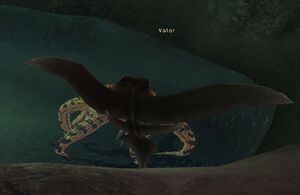Valor
| Valor | |
|---|---|
| Job: | Paladin |
| Family: | Sea Monks |
| Crystal: | None |
| Weak against: | Water |
| Notorious Monster | |
| Zone | Level | Drops | Steal | Spawns | Notes | ||||||
|---|---|---|---|---|---|---|---|---|---|---|---|
| Quicksand Caves | 70 | 1 | |||||||||
|
HP = Detects Low HP; M = Detects Magic; Sc = Follows by Scent; T(S) = True-sight; T(H) = True-hearing JA = Detects job abilities; WS = Detects weaponskills; Z(D) = Asleep in Daytime; Z(N) = Asleep at Nighttime; A(R) = Aggressive to Reive participants | |||||||||||
| Spawn Conditions | Companions/Summons |
|---|---|
|
|
| Special Abilities | Passive Traits |
|
|
| Further Notes | |
(see testimonials) | |
Historical Background
In Japanese Buddhist belief, the Nio were two guardians of the Buddha. They are usually depicted as terrifying, muscular statues standing beside the entrance of Buddhist temples. One was named Agyo or Shukongoshin, who embodies manifest power or strength. He is depicted wielding a rod and is showing his teeth. The other was named Ungyo or Kongorikishi, who embodies latent power or strength. He is shown wielding a sword (or having no weapon) and has his mouth shut. Their scary appearance was meant to ward off evil spirits, thieves, and demons. Their role is security, to protect the faith and the visitors to the temples (practitioners of the faith), and thus lack the calm, serene expressions of figures seeking enlightenment. Nio is Japanese for "two kings".
A and Hum are derived from a and un, Japanese translation of a & om from Hinduism (e.g. aum), symbolizing the beginning and the end, birth and death (parallel to alpha & omega in the Greek alphabet). This carries into the names of Agyo (a) and Ungyo (un) and their mouths, the former being open to emulate making the a sound and symbolizing birth, beginning, the latter being closed to emulate making the un sound and symbolizing death, ending.

